In planning the Historical Sew Fortnightly challenges, I look for themes that can be interpreted in a number of interesting ways, can be used to create very basic, or extremely elaborate garments, and can fit across the many time-periods that we sew in. I’ll admit that I sometimes take into account my own sewing list, and schedule challenges that encompass a project I’d been hoping to do for a while.
I’ve got a confession though. Challenge #19 is the first time I’ve totally dumped the theme I’d originally planned, and completely themed a challenge around an item I desperately need to make (1860s hoopskirt), and which I couldn’t find a way to fit into any other challenge.
Still, I think it’s a pretty awesome theme, with lots of scope, so I hope you will forgive my selfishness!
Challenge #19 is ‘Wood, Metal, Bone’: Cloth may be the most obvious material in historic costuming, but wood, metal, and bone are just as important to creating the right look and silhouette. They are often, literally, the foundations of a period garment, with shoes made from wood; skirt supports made from wood, metal or bone; and bodies and bodices shaped with the same. Wood, metal and bone provided the finishing touches too garments too, in metal jewellery, wood and bone fan sticks, and straw hats. For this challenge, make anything that incorporates wood, metal, or bone.
In most challenges, I try to avoid being too didactic and specific, because I think it is more important that people get creative with a theme. However, I do have some specifics for this challenge:
Wood: also encompasses cane and straw. You may also count rayon and other wood/cellulose based fibres as wood (ooh, clever!), but only if they are appropriate to your period and garment (so no Regency rayon frocks, but 1930s is a possibility). Rayon was commercially available in many places (including New Zealand) from 1911 onwards, but researching what types of garments it was used for is up to you.
Metal: Pretty obvious. Metal is metal. Metal jewellery, metal lace (not just metallic coloured lace though), cloth of metal (still possible to find, very occasionally), metal boning.
Bone: includes any of the types of plastic boning (cable ties, featherboning etc) that are used as modern replacements to period use of whalebone (technically baleen, but you know what I mean).
To inspire you, here are a few images of historical wood-y/metal-y/bone-y garments that inspire me.

Portrait of a Young Woman Giovanni Battista Moroni, 1564-70
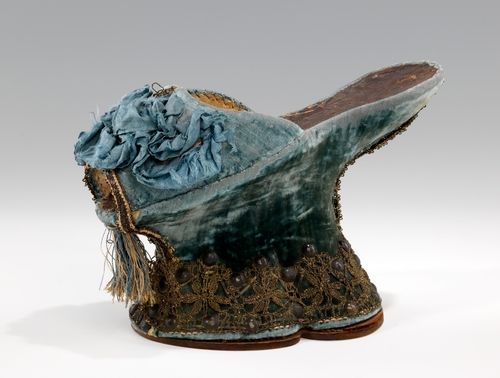
Chopines with wooden heels, covered with leather, silk and metal lace, 1590-1610, Metropolitan Museum of Art
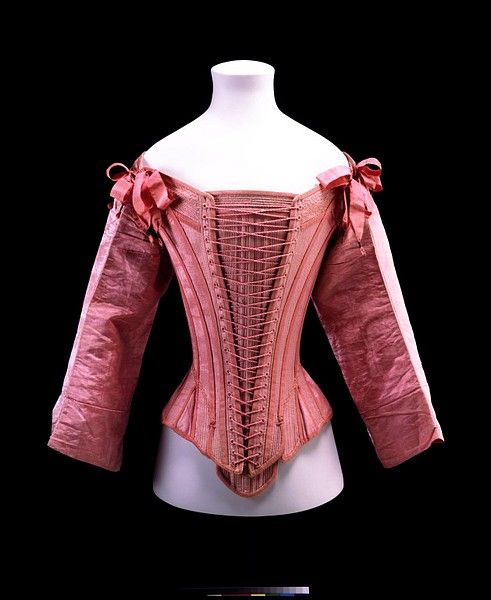
Stays with sleeves 1660-70 Victoria & Albert Museum

Parasol in two parts, silk and wood, French, MFA Boston
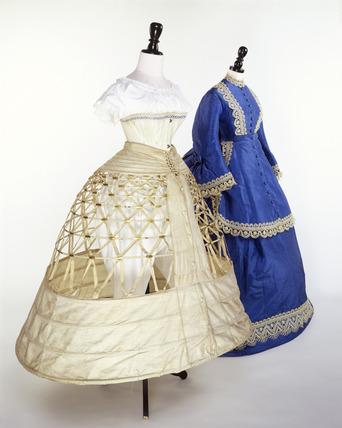
Hoopskirt, corset & wedding dress, 1860s, Museum of London
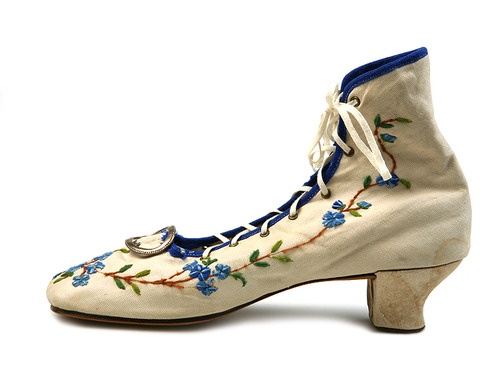
Lady’s canvas pumps with very high back lacing through seven metal eyelets. Decorated with embroidery. Low knock on heel, France, circa 1860-1865.
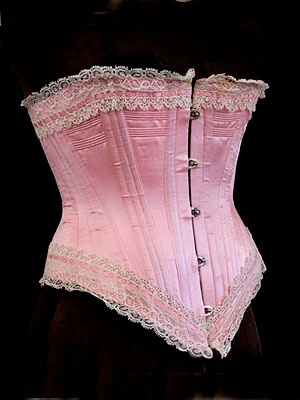
Pink satin corset, c.1890, Vintage Textile
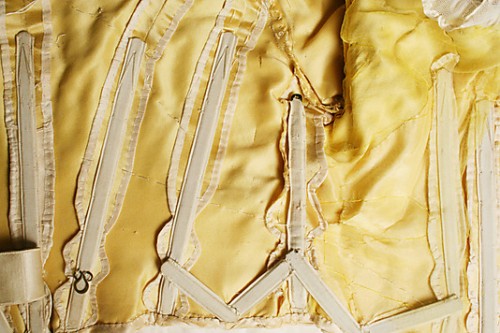
Detail of the interior construction of the bodice of an evening dress by Duval and Eagan (American), ca. 1889, silk with whalebone, Metropolitan Museum of Art
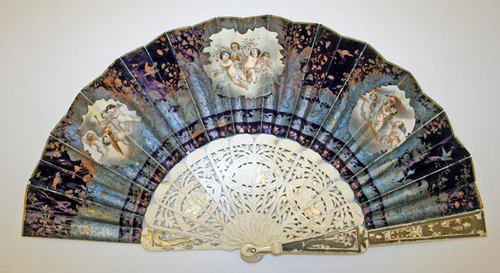
Fan with ivory sticks, late 19th century, Metropolitan Museum of Art
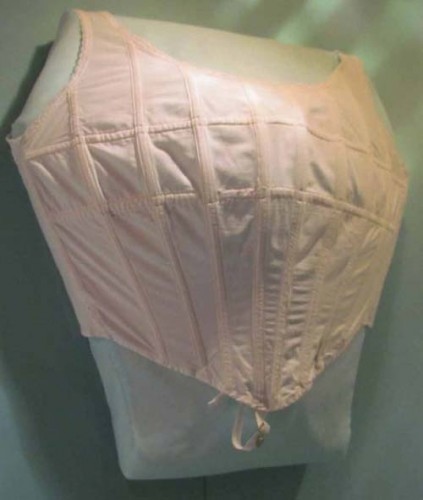
Bust improver or reducer, made of cotton with metal boning, by Spirella Styles, (patented) 1907, DAR exhibition

Evening bag with metal clasp and chain, early-mid 20th century
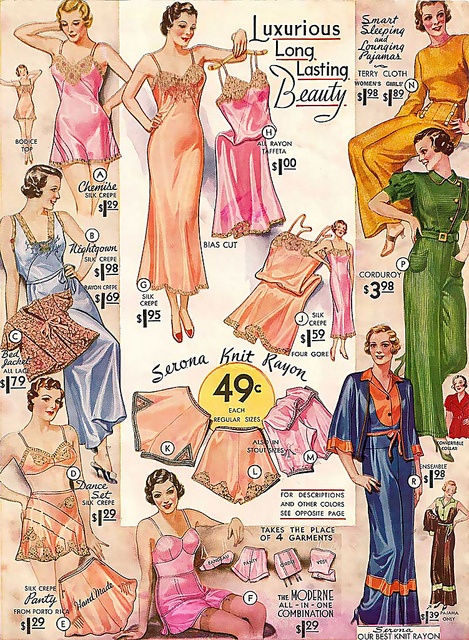
Pyjamas and lingere in rayon, 1934


Awesome! I love challenges that can be interpreted in lots of different ways.
I’m really glad that zip ties count as “bone”.
Yay! I feel like many of the challenges are open to lots of interpretation, but I also want them to push people out of their comfort zones and sewing patterns, so they have to be specific enough too 😉
They’ve certainly got me sewing lots of things I’d never even thought about or planned – and I’m the one picking the themes! So it’s working!
Me too, I never would have made that ridiculous hat if it hadn’t been for the challenge, or the cravat, or started the plaid apron that I haven’t finished yet. It’s also made me finish some UFO’s.
So, yes! The challenge is working here too.
It’s working for me too. I hand sewed an entire garment and plan to do it again. Never saw that coming!
How about metal buttons? Hooks and eyes?
There are so many possibilities I see for this challenge, it’s not even funny.
And now I want corduroy lounging pyjamas. Well, not now, because right now I’m wearing only my lightweight chemise and am still somewhat hot.
Yep! I’m hoping people go a little further than just something that happens to have metal hooks, but really, anything that encourages us to sew and get things done is good!
It’s the middle of winter here, and we’re about to get hit with a ‘polar blast’ with freezing temperatures, but corduroy lounging pyjamas still sound too hot for me! And more fashionable than comfortable, if you can describe corduroy as fashionable!
They would be perfect for those transitional periods when we stop heating (or do not start yet) in our 18th century house with thick thick walls. 😉 The temperature in such cases quickly plummets to 17 Celsius or so, and when you sit, something warm to wear is good. Plus, I’m thinking of the softer type of corduroy – what is it called?
We’re having crazy weather. We had a looong winter, then rain and floods, now suddenly it’s hot!
I was thinking more of the buttons, actually. You know, those large decorative metal ones, military-style.
Hahahaha…”plummets to 17 Celcius”.
NZ isn’t as cold as most of Europe, but 17 is a sadly reasonable indoor temperature by NZ standards. According to government surveys, the average indoor winter temperature in a NZ house is 16 degrees. I used to work at a job in a fancy office building in the Wellington CBD where the temperature under my desk all winter long was regularly 12 Celcius. I very much doubt that the temperature in my living and sewing rooms today are as high as 17 degrees. I just wear jeans and layers of wool socks and merino. Corduroy wouldn’t be nearly warm enough. The super soft corduroy is nice through.
And large metal buttons would be fantastic. For me it’s the difference between something being a minor part of a project, and making the project.
“plummets to 17 Celsius”? I laugh at that too.
It’s 18º Celsius outside right now and it’s lovely, the perfect temperature. It’s early summer here, but in the winter it can get as low as -30 or -40 Celsius. Plus several feet of snow.
I’m considering stays with a wooden busk.
Hana and I are talking about indoor temperatures – outdoor temperatures are a totally different thing! -40 is fine as long as your house is insulated and heated. 18 is fantastic as an outdoor temperature, because you are moving in it, and OK as an indoor temperature, but anything below that is unhealthy for a normal adult, and a real threat to children, invalids and older people. So 17 degrees indoors? Not good. The 16 average in NZ? Really, really bad. Much worse than the many places in the world that get colder outside, but have proper insulation and heating.
That is pretty bad, pardon my confusion.
My room was actually around 16 a few winters ago, but we got the heat fixed.
That’s crazy about NZ houses… especially those 12 degrees Celsius. That’s just four degrees more than a fridge!
When such a temperature has been more or less the standard for a while, you get somewhat used to it, and yes, wear warm clothes (plus in normal years, it usually gets warm outside gradually). But the change when we stop heating is always a shock. Plus, this house, patched as it is from brick, stone and adobe (seriously), tends to retain moisture and everything goes moldy. The thick walls are great in winter and summer, but less so in transitional periods.
This is doing my day-to-day dressmaking no good whatsoever, as I keep thinking of things to make for challenges! Today at work I found my mind wandering off to, “I wonder if straw counts as ‘wood’ for this challenge?” And it does. Yay! (Although I’m not sure my idea will actually work, but it’s worth a try.)
There again, I’m totally in love with the evening bag pictured above.
I am sooo impressed with the way you have come up with challenges which are so different, but at the same time lots of them could be interpreted within a relatively small period or area of interest, if you didn’t want to end up with 26 totally unrelated items at the end of it.
Well, thank you! I’m so pleased people are finding that the challenges work for their sewing. I’ve actually got twice as many ideas for challenges as I’ve managed to fit in! There might have to be a Sew Fortnightly 2014 ;-).
I know how you feel though. All the challenges do give me a list of 50 things that I want to get done for every challenge! Overall though it has done wonders for my sewing. I have made so many things that will be helpful for general costuming, but which I never would have gotten to otherwise.
“a Sew Fortnightly 2014”
Ooh I do hope so! I looked at your post and thought, “Challenge 19? But that’s only 7 left. Oh no!”
Hopefully I’ll be able to make an underbust corset for this one, if I have enough saved up for all the supplies…If not, I’ll try to do something else that I have things for around the house.
Corset supplies sure are expensive. People just don’t understand until they go to make their own.
Yeah, I made one a while ago and it’s definitely the cost that keeps me from making another, though I really want to because I know I could do a better job of it now after having more sewing experience.
I really, really want to make chopines for this challenge.
That would be AMAZING!
I really want to participate in this and I have a corset pattern from a book that I want to work on, the problem is….I’ve never enlarged a pattern or sized it after to my measurements! Can someone help me figure out how to do that? Are there pages that anyone can recommend a tutorial or something as a guide?
I’ve finished a challenge on time, I’m so happy, even though it was a UFO! It’s a needle house, inspired by Sami needle houses, so not a garment but an accessory to an outfit:
http://caddamsbetraktelser.wordpress.com/2013/09/18/hsf-19-wood-metal-bone-needles-and-pins-in-bone/
[…] First, I want to say “Thank you!” to all of you who provided me with your thoughts and insights about my Curtain Along troubles. I took all of the things that you mentioned and reconsidered my jacket, coming at last to the conclusion that a stomacher would solve a lot of my problems. Of course then I had to decide if I wanted my jacket to lace over or pin to the stomacher and how I wanted to trim the new design (ribbon or self trim)… for now I’ll leave you in suspense on those two points, because the point of this post is to share my completion of the stomacher, as it fits into the HSF Challenge #19: Wood, Metal, Bone. […]
[WORDPRESS HASHCASH] The comment’s server IP (76.74.254.9) doesn’t match the comment’s URL host IP (66.155.9.238) and so is spam.
I’ve just posted about my entry for this challenge: an 18th century stomacher boned with cane.
http://quinnmburgess.wordpress.com/2013/09/19/hsf-19-mineral-felicite-stomacher/
Best,
Quinn
http://isabelladangelo.blogspot.com/2013/09/historical-fortnightly-19-wood-metal.html
More pictures later but I made chopines!!!
OK, now that is impressive!
I made a wooden busk
http://mouseborgdesigns.blogspot.ca/2013/09/wooden-busk.html
I’ve barely started the stays that are going to go with it, so it’s a good thing that busks are separate items.
Woefully late, but I’ve finally finished my entry; a 1930s straw bag.
http://blacktulipsewing.blogspot.co.uk/search/label/straw%20bag
Late, I know, but here is my entry anyway. 1770’s stays base on the ones in Costume Close-Up. My blog entry: http://livingwithjane.blogspot.com/2013/10/historical-sew-fortnightly-challenge-19.html